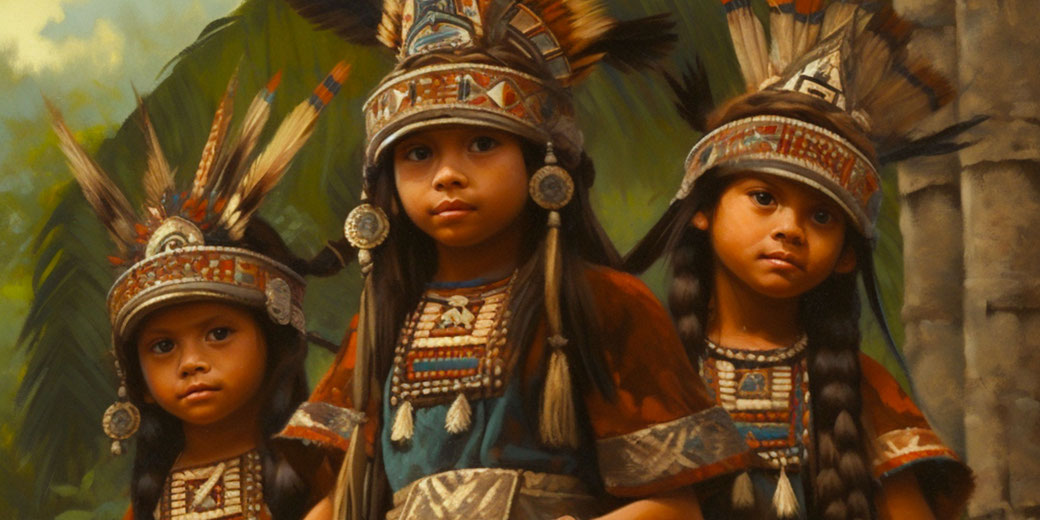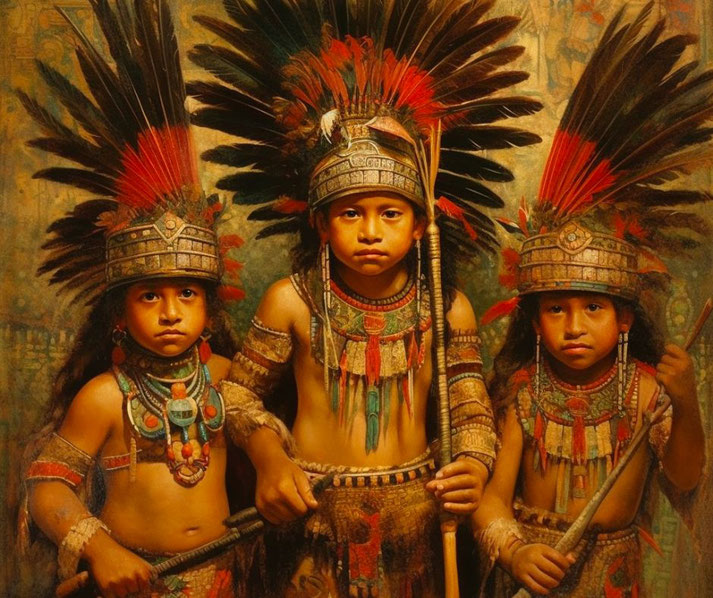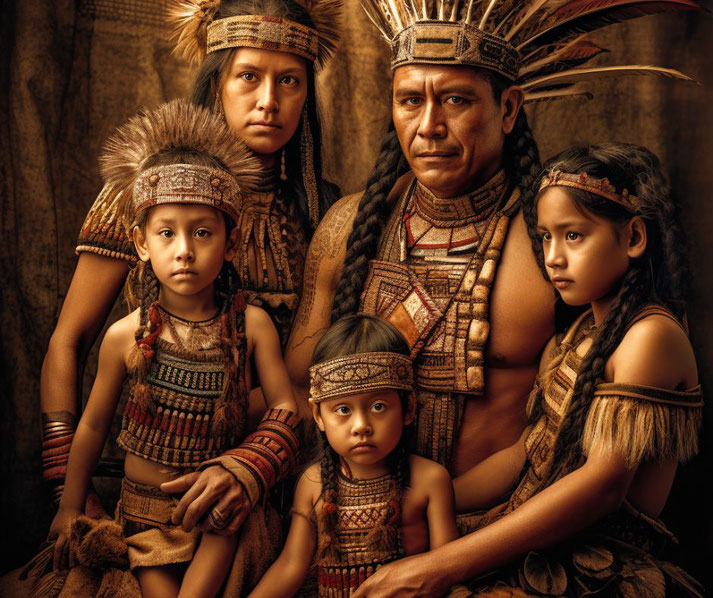Growing up Aztec: What were the lives of children like in the Aztec Empire?

In the bustling markets, the grand temples, and the verdant fields of the Aztec Empire, children were not just silent spectators, but active participants shaping and being shaped by the vibrant tapestry of Aztec life.
They were the promise of continuity and the bearers of tradition, learning the ways of their ancestors even as they infused their youthful spirit into the wider Aztec society.
Yet, who were these 'children of the sun'?
How did they navigate the rigors of their daily routines, their arduous education, and the grandeur of their religious rituals?
What did play mean to them, and what were their rights according to Aztec laws?
The place of children in the Aztec social structure
The Aztecs lived in an intricately stratified society, where an individual's status was often determined at birth, shaping their experiences and expectations throughout their life, including their childhood.
The Aztec society was predominantly divided into two major classes: the Pipiltin (nobility) and the Macehualtin (commoners).
This rigid social hierarchy was instrumental in determining the course of a child's life from the very beginning.
While the children of nobles were destined for lives of privilege and power, the children of commoners had a very different future, often characterized by labor and service.
At the apex of this structure was the Tlatoani, or the emperor, followed by a nobility class, which included high-ranking warriors, priests, and government officials.
These children were afforded a privileged upbringing, often receiving advanced education in the calmecac – an elite school dedicated to training future leaders and priests.
Here, the children studied theology, astronomy, art, and governance among other disciplines, their learning steeped in the strong spiritual traditions of their culture.

In contrast, the majority of Aztec children belonged to the Macehualtin, who were mainly farmers, traders, and artisans.
These children were typically educated at home or in telpochcalli – schools for commoners – where the curriculum was primarily focused on physical training, moral education, and learning practical trades.
Though the opportunities for social mobility were relatively limited, a commoner's child who demonstrated exceptional skills, particularly in warfare, could rise in status.
Below the Macehualtin were the Mayeques and Tlacotin, serfs and slaves, respectively.
These groups occupied the lowest strata of society, and their children often led lives of hardship and servitude, though it was possible for them to gain freedom under specific circumstances.
Birth and early infancy
From the moment of conception, the child's destiny was considered intertwined with the cosmic forces that the Aztecs held sacred.
The trecena, a 13-day period in the Aztec calendar, during which a child was born was believed to influence their personality and destiny.
Similarly, the tonalli, a spiritual force associated with birth, was believed to be determined by the day of birth.
Both the trecena and the tonalli were carefully noted at the time of birth, shaping the child's spiritual identity.
Birth rituals often involved a midwife, or 'Ticitl', a respected figure in Aztec society.
The midwife not only helped with the physical process of childbirth but also performed sacred rituals to welcome the child into the world.
Following the birth, she would cleanse the baby, announce its birth to the community, and perform ceremonies to protect the baby from evil spirits.
During infancy, the child was cared for primarily by the mother, though raising a child was viewed as a communal responsibility.
Nutrition during these early years came from breastfeeding, which was universally practiced.
Aztec mothers, aware of the health benefits, breastfed their infants until they were at least two years old, contributing to the child's immunity and overall health.
The naming ceremony, which took place a few days after birth, was another significant event.
During this ritual, the child was given a name, and a symbolic bath was conducted by the midwife, which marked the child's formal introduction into the Aztec society.
This was a joyous occasion, filled with prayers, feasting, and music.
Time to go to school
Education held a vital place in Aztec society, reflecting their belief in the importance of cultivating knowledge, discipline, and societal roles from an early age.
Remarkably egalitarian for its time, the Aztec educational system was one of the first to implement compulsory education for children, regardless of their social status.
However, the nature and extent of this education varied significantly depending on the child's gender and social class.
At the heart of Aztec education were two types of institutions: the Calmecac and the Telpochcalli.
The Calmecac, often situated near the temple, was typically reserved for the children of nobility and those destined for religious or political leadership.
The curriculum in the Calmecac was comprehensive, providing instruction in history, astronomy, art, theology, law, and various other disciplines.
In addition, students learned the complex pictorial writing system of the Aztecs, enabling them to read and interpret the empire's vast codices.

On the other hand, the Telpochcalli, also known as the "house of youth," was where the majority of Aztec children, particularly those from commoner families, received their education.
The emphasis here was more on physical training and the acquisition of practical skills.
Lessons included martial arts, agriculture, craftsmanship, and trade, aimed at preparing the students for the societal roles they would assume as adults.
Girls' education, whether noble or commoner, was typically centered around the home, where they were taught by their mothers and elder women in the community.
They learned the arts of cooking, weaving, and child-rearing, in addition to moral and religious lessons.
However, noble girls could also attend the Calmecac to receive religious instruction.
Children started their education as early as their toddler years, initially in the family setting and later in either the Calmecac or Telpochcalli by the age of 15.
Discipline was an integral part of Aztec education, and corporal punishment was common for those who disobeyed or failed to meet the standards.
The differences for girls and boys
The Aztec society was steeped in gender norms that strongly influenced the experiences of childhood.
From birth, boys and girls were treated differently, raised with distinct expectations, and trained for specific roles within society.
While boys were prepared for positions in warfare, politics, or priesthood, girls were groomed for domestic life or religious service.
Boys' upbringing in the Aztec Empire was centered around building physical strength, valor, and practical skills.
The expectation was to grow into brave warriors or efficient farmers, depending on their social class.
For the nobility and those destined to become priests, in-depth knowledge of religion, law, and astronomy was crucial.
Hunting and fishing were common pastimes, which also served as survival skills training.
They were also taught to handle weapons and to be always prepared for warfare.
Girls, on the other hand, were primed for their future roles as wives, mothers, or priestesses.
From a young age, they were taught domestic duties by their mothers and elder women in the community.
These included cooking, weaving, pottery, child-rearing, and maintaining a household.
For girls from noble families or those destined to be priestesses, religious education was significant.
Many of them learned to sing religious songs, perform rituals, and some even learned to read and write in the pictorial language of the Aztecs.
From child to adult: Coming of age rituals
Coming of age in the Aztec Empire was a significant milestone, marked by a series of intricate rituals that signified a child's transition to adulthood.
These ceremonies, filled with symbolism and deeply rooted in Aztec spirituality, underscored the societal roles that young men and women were expected to assume.
For boys, the journey to manhood was closely associated with their capacity to contribute to the defense and productivity of the empire.
The transition was often marked by a test of physical strength or endurance, symbolizing their readiness to take on adult responsibilities.
Among the nobility and warrior class, this might involve participation in a battle or a public demonstration of martial prowess.
For boys from commoner families, it could be associated with their ability to undertake significant tasks in farming, trade, or craftsmanship.

Regardless of their social class, all boys were expected to undergo a ritual haircut as part of their coming-of-age ceremony.
The hair, which had been grown long since birth, was cut to signify the boy's transition into manhood.
This haircut was typically performed by a respected member of the community, such as a priest or a warrior, and was followed by a feast to celebrate the milestone.
Girls' transition into womanhood was marked by their first menstruation, a significant event viewed as their passage into the sphere of fertility and motherhood.
This was often accompanied by a ceremony called the Izcalli. During this ceremony, the young woman's hair, which had been worn loose until then, was bound up in two braids, the typical hairstyle for Aztec women.
This change symbolized her readiness for marriage and the responsibilities of adult womanhood.
In some cases, the coming-of-age ceremony for girls also involved a ritual piercing of the lower lip, symbolizing her transition into womanhood.
The young woman was then given further instructions on her roles and responsibilities as an adult woman in Aztec society, particularly around marriage, motherhood, and domestic duties.
These coming-of-age rituals served as a rite of passage, not just for the individual, but for the community as a whole.
They reinforced societal norms and expectations, strengthened communal bonds, and perpetuated the cultural and spiritual traditions of the Aztec Empire.
The brutal reality for children in war time
War and warfare were integral aspects of Aztec society, deeply intertwined with their culture, economy, and religion.
As such, times of war had profound effects on all segments of Aztec society, including its youngest members.
Childhood during these periods was marked by a unique set of experiences, expectations, and challenges.
From an early age, boys were introduced to the ethos of bravery and sacrifice that underpinned Aztec martial culture.
During times of war, this training intensified. Young boys would accompany men to the battlefield, not to fight, but to observe and learn.
They were witness to the strategies, techniques, and rituals associated with warfare, and these experiences often served as a rite of passage into manhood.
War also had implications for the education of children. In the Telpochcalli, or the commoners' school, the emphasis on physical training and martial arts would heighten during wartime.
Lessons on weaponry, tactics, and the martial code of honor became central to a boy's education.
In the Calmecac, where the nobility were educated, students would delve deeper into the strategic and ritualistic aspects of warfare.
They would also focus on studying the military histories and legends of their ancestors.
For girls, times of war brought a different set of responsibilities and experiences. With men away at war, they often had to take on additional duties within the family, such as tending to farms or overseeing family businesses.
Girls also participated in war efforts by preparing food and materials for the warriors, caring for the wounded, and performing rituals to pray for victory and the safe return of their warriors.
War impacted not just the activities and responsibilities of Aztec children, but also their emotional world.
They had to grapple with the realities of danger, loss, and sacrifice at a tender age. The glory associated with victory or the honor of sacrifice were concepts they had to comprehend and internalize.
Childhood during times of war in the Aztec Empire, therefore, was a period of accelerated maturation.

The dark role of Aztec religion in childhood
The religious influence began right at birth, with a ceremony performed by a midwife, who was also a religious figure.
The tonalli, a spiritual force associated with the day of birth, was believed to shape the child's personality and destiny, underscoring the interplay between earthly life and cosmic forces in the Aztec worldview.
Aztec children were introduced to the pantheon of gods and goddesses from a very young age.
They were taught to pay tribute to these deities through rituals, offerings, and prayers, fostering a sense of piety and respect for the divine.
Children were also familiarized with the many festivals and ceremonies that marked the Aztec religious calendar, often participating in these celebrations.
Education, too, was steeped in religious influence. In the Calmecac, children from noble families or those destined for priesthood received comprehensive religious education.
They studied theology, learned about the religious significance of astronomy and calendar systems, and were trained in conducting rituals and ceremonies.
In the Telpochcalli, or the commoners' school, moral and ethical education based on religious teachings was emphasized.
Religion also played a significant role in shaping the moral code for Aztec children.
They were taught the importance of virtues like courage, honor, respect, and piety.
Stories of gods, mythical heroes, and ancestral warriors were common tools for imparting these lessons.
However, the religious influence on childhood in the Aztec Empire also had its darker aspects.
The Aztec religion involved human sacrifice as a means of appeasing and honoring the gods.
While most of the individuals chosen for sacrifice were captured warriors, there were instances where children were selected, particularly for ceremonies devoted to certain deities.
What games did Aztec children play?
Despite the rigorous education and training, Aztec children, like children anywhere, had time for games, leisure, and creativity.
These playful activities provided a necessary counterbalance to their disciplined lives, and also served as important tools for socialization, learning, and the development of important skills.
One of the most popular games among Aztec children was Tlachtli, also known as the Mesoamerican ball game.
This was a complex game that involved hitting a rubber ball through stone hoops using only the hips, knees, or elbows.
Children often played simplified versions of this game, which helped develop their physical strength and coordination, and also familiarized them with one of the most important ceremonial games of the Aztec culture.
Other common games were Patolli, a board game involving beans as dice, and Totoloque, where the aim was to throw gold or copper discs onto a pointed stake.
These games were enjoyable and competitive, but they also fostered mathematical and strategic thinking.
Toy animals made from clay or wood were popular among younger children, serving as a source of entertainment and also as tools for learning about the natural world.
Girls would often play with miniature versions of household items like pottery, weaving tools, and dolls, which served as playful practice for their future domestic roles.
Aztec children also engaged in leisurely activities that connected them with their natural surroundings.
They would often swim in the lakes and canals, go for walks in the woods, or watch animals, birds, and insects.
Storytelling and listening to music were other common leisure activities, which played a crucial role in the transmission of cultural knowledge and traditions.
Games and leisure activities, therefore, had an important place in the lives of Aztec children.
They served as a respite from their disciplined routines, provided opportunities for social interaction, and fostered the development of physical, cognitive, and social skills.
What 'rights' did children have?
When it comes to children's rights and laws in the Aztec Empire, it is important to understand that the concept of 'rights' as we understand it today was not part of their legal and social framework.
Instead, Aztec society had a set of norms, expectations, and laws that governed the treatment and behavior of children.
These regulations reflected the societal values of the Aztecs, emphasizing discipline, respect, and the fulfilling of social roles.
The well-being of children was a responsibility shared by the family and the wider community.
Parents were expected to care for their children, provide for their needs, and guide their moral and social development.
They were allowed to discipline their children, but excessive or harsh punishment was discouraged.
Elders, teachers, and community leaders also played a role in ensuring the welfare and proper conduct of children.
Children were expected to obey their parents and elders, respect societal norms, and contribute to their families and communities through work and social duties.
Disobedience, disrespect, and idleness were considered serious transgressions, often met with severe punishment.
The Aztec legal system also had specific provisions for children. For instance, children were generally exempt from severe legal penalties, recognizing their lack of maturity.
However, serious offenses like theft or violence could lead to stringent punishment, even for children.
Aztec society also had laws to protect children in specific circumstances. Orphans, for instance, were usually taken care of by their extended family or community.
If parents died owing debts, their children were not obligated to repay them.
The education of children was a societal obligation, ensuring that each child, regardless of their social background, received training and instruction appropriate for their future roles.
The Calmecac and the Telpochcalli, the two main types of schools, catered to different segments of the society, but both aimed to equip children with the skills, knowledge, and values necessary for their adult life.
What do you need help with?
Download ready-to-use digital learning resources
Copyright © History Skills 2014-2024.
Contact via email
With the exception of links to external sites, some historical sources and extracts from specific publications, all content on this website is copyrighted by History Skills. This content may not be copied, republished or redistributed without written permission from the website creator. Please use the Contact page to obtain relevant permission.





